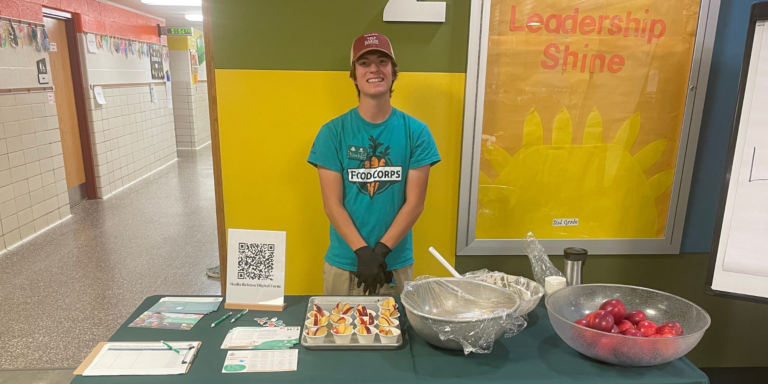6 Things You Need to Know About School Food
School food has come a long way since the ’80s and ’90s, thanks to innovative school food leaders.
School food has come a long way since the ’80s and ’90s, thanks to innovative school food leaders.

This post was last updated on October 2, 2023.
Every day, over 30 million children participate in the National School Lunch Program. This federal meals program has evolved dramatically since its inception, yet despite considerable progress, it’s still challenging to make nourishing, locally sourced, and culturally relevant school food the norm in cafeterias across America.
As FoodCorps works to increase kids’ demand for nutritious food through education, we’re also supporting school nutrition professionals in shaping what shows up on the lunch tray. Here are six things we want you to know about school food:
Serving 4.9 billion (yes, BILLION) school lunches annually, the school food industry is larger than the nation’s largest restaurant chains. In fact, there are seven times more schools in America than there are McDonald’s franchises.
But this system doesn’t operate anything like a high-functioning franchise. The school food system is full of complex and bureaucratic processes that present unique challenges to school food leaders as they source and serve nourishing food. And like much of the education system, the school food industry has been deeply shaped by systemic racism and other systemic injustices.
Before school lunch even gets to a child’s plate, food service directors (the people who oversee meals for school districts) choose products from a seemingly endless list of processed and fresh foods. Buying food for a school district requires knowing dozens of non-standardized processes and navigating time-consuming state and federal regulations and reporting requirements, not to mention wading through the inch-thick catalogues of products and attending massive annual trade shows.
Food service directors and their staff also plan menus, negotiate contracts with food distributors, hire and manage staff, run daily cafeteria operations, and collaborate with custodial and administrative staff. And not all districts are alike: a district’s size, the number of students receiving free or reduced-price meals, and geography can affect these leaders’ access to resources, their purchasing power, and their access to markets, making it challenging to innovate, collaborate, or systematize processes nationally.
School food is a $15 billion industry, but even so, school districts are not provided with the appropriate level of funding needed to purchase high-quality food. On average, public school districts only have $1.19 to spend on each student’s lunch. The remaining funding goes to labor, supplies, benefits, and other indirect costs.
While there are many barriers to serving nourishing meals in schools, there’s been a lot of progress in recent years thanks to updated policies and innovation led by school districts and partner organizations.
What happened? Quick history lesson: in 1946, the National School Lunch Act was signed into law, originally intended as an agricultural subsidy program that expanded access to healthy meals for undernourished children. By the 1980s, the federal budget was cut, lunch portions were downsized, and dietary requirements were modified.
With less federal support, schools started to rely on cheaper processed foods in their meal programs. In 2010, the Healthy, Hunger-Free Kids Act required cafeterias to offer more fruits, vegetables, and whole grains in every school meal, a huge win for kids, schools, and communities.
In addition to policies putting more nutritious food on lunch trays, school nutrition professionals have been leading their own initiatives in the cafeteria. School districts are piloting scratch cooking, installing salad bars, providing sauce and spice stations, and conducting taste tests that allow students to participate in the meal planning process.
None of this transformative change would be possible without innovative, action-oriented food service leaders at the helm. Rodney Taylor piloted salad bars and farm to school initiatives in Southern California before moving to the school district in Fairfax County, Virginia, where he envisions options “similar to those in [kids’] favorite fast-casual eateries, with salad bars, fresh wraps and made-to-order burritos.”
Jennifer LeBarre, formerly the food services director of the Oakland Unified School District, championed the creation of a centralized kitchen where fresh, local foods can be delivered and scratch-cooked in large quantities, while offering culinary training and more jobs for Oakland residents.
Many food service leaders in large urban districts have banded together through the Urban School Food Alliance to leverage their purchasing power for healthier, more sustainable meals – resulting in more antibiotic-free chicken in schools and meals served on compostable trays.
While these shifts have moved the needle, we have more work to do to make school food nourishing and accessible to all.
If we want to overcome the many barriers in the school food system, we need more visionary school food leaders who have the persistence and dedication needed to make tough decisions and make use of limited resources. Programs like FOLCS, FoodCorps’ network for food operators and leaders of color to connect and learn from one another, are helping to bring more diverse lived experiences to the table.
Want to learn more? Read our PreK-12 School Food: Making It Healthier, Making It Regional report and case studies written in collaboration with School Food Focus.

The Policy Brief, Fall 2024: After the Election

Food as Medicine: Teaching Indigenous Foodways

A Day in the Life: Noah Doederlein, School Nutrition Member